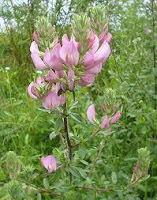Field Restharrow has a tough weedy stem which could halt the harrows used to till soil, hence its name. The ancient herbalists used this plant to treat bladder and kidney stones and as a diuretic. It is a native of Europe and found in Britain
 It is endangered and protected in
It is endangered and protected in This plant contains essential oils, flavonoids, glycosides and tannins, with the root being the part employed in traditional systems of medicine in Europe . The root is harvested in September and October, and dried for later use. It is used to stop bleeding from fresh wounds, for headaches, rheumatism skin problems, infections of the urethra and piles. It has been in the official Pharmacopoeias of the former Soviet Union states, the Czech Republic Serbia Austria
A decoction of the root was used for skin problems as an external wash and an infusion was used incases of delirium.
Currently research is being carried out into its flavonoid contents




No comments:
Post a Comment